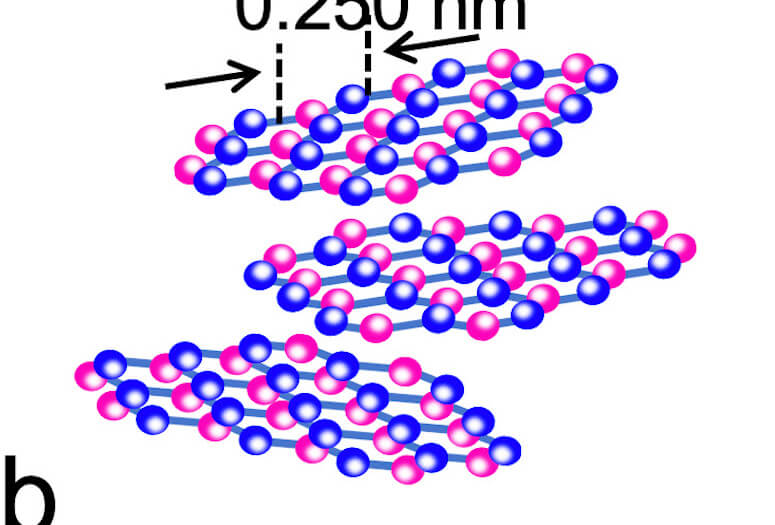Rice University scientists who “flash” materials to synthesize substances like graphene have turned their attention to boron nitride, highly valued for its thermal and chemical stability.
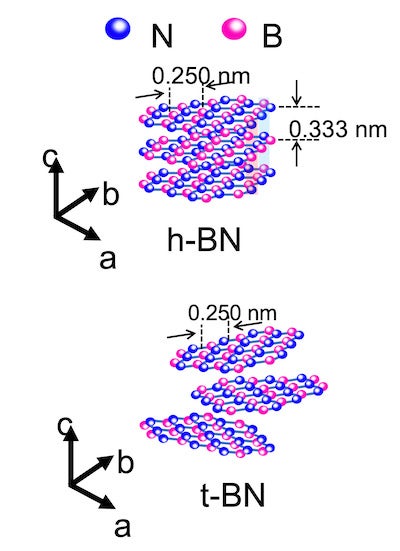
The process by the Rice lab of chemist James Tour exposes a precursor to rapid heating and cooling to produce two-dimensional materials, in this case pure boron nitride and boron carbon nitride. Both have until now been hard to create in bulk, and nearly impossible to produce in easily soluble form.
The lab’s report in Advanced Materials details how flash Joule heating, a technique introduced by the Tour lab in 2020, can be tuned to prepare purified, microscopic flakes of boron nitride with varying degrees of carbon.
Experiments with the material showed boron nitride flakes can be used as part of a powerful anticorrosive coating.
“Boron nitride is a highly sought 2D material,” Tour said. “To be able to make it in bulk, and now with mixed amounts of carbon, makes it even more versatile.”
At the nanoscale, boron nitride comes in several forms, including a hexagonal configuration that looks like graphene but with alternating boron and nitrogen atoms instead of carbon. Boron nitride is soft, so it’s often used as a lubricant and as an additive to cosmetics, and is also found in ceramics and metal compounds to improve their ability to handle high heat.
Rice chemical engineer Michael Wong recently reported that boron nitride is an effective catalyst in helping to destroy PFAS, a dangerous “forever chemical” found in the environment and in humans.
Flash Joule heating involves stuffing source materials between two electrodes in a tube and sending a quick jolt of electricity through them. For graphene, the materials can be just about anything containing carbon, food waste and used plastic car parts being just two examples. The process has also successfully isolated rare earth elements from coal fly ash and other feedstocks.
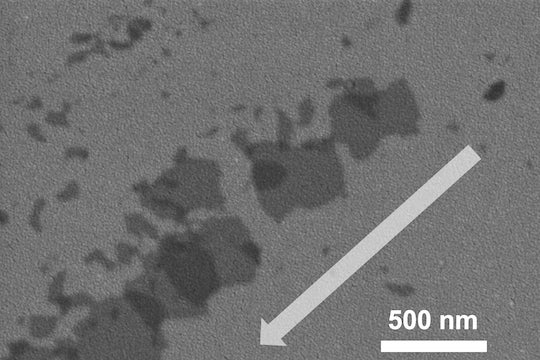
In experiments led by Rice graduate student Weiyin Chen, the lab fed ammonia borane (BH3NH3) into the flash chamber with varying amounts of carbon black, depending on the desired product. The sample was then flashed twice, first with 200 volts to degas the sample of extraneous elements and again with 150 volts to complete the process, with a total flashing time of less than a second.
Microscope images showed the flakes are turbostratic — that is, misaligned like badly stacked plates — with weakened interactions between them. That makes the flakes easy to separate.
They’re also easily soluble, which led to the anticorrosion experiments. The lab mixed flash boron nitride with polyvinyl alcohol (PVA), painted the compound on copper film and exposed the surface to electrochemical oxidation in a bath of sulfuric acid.
The flashed compound proved more than 92% better at protecting the copper than PVA alone or a similar compound with commercial hexagonal boron nitride. Microscopic images showed the compound created “tortuous diffusion pathways for corrosive electrolytes,” to reach the copper, and also prevented metal ions from migrating.


Chen said the conductivity of the precursor can be adjusted not only by adding carbon but also with iron or tungsten.
He said the lab sees potential for flashing additional materials. “Precursors that have been used in other methods, such as hydrothermal and chemical vapor deposition, can be tried in our flash method to see if we can prepare more products with metastable features,” Chen said. “We’ve demonstrated flashing metastable phase metal carbides and transition metal dichalcogenides, and this part is worth more research.”
Co-authors of the study are Rice alumni John Tianci Li, Wala Algozeeb, Paul Advincula, Emily McHugh and Duy Xuan Luong, graduate students Chang Ge, Zhe Yuan, Jinhang Chen, Kexin Ling, Chi Hun Choi, Kevin Wyss and Zhe Wang, research scientist Guanhui Gao and Yimo Han, an assistant professor of materials science and nanoengineering. Tour is the T.T. and W.F. Chao Chair in Chemistry as well as a professor of computer science and of materials science and nanoengineering at Rice.
The Air Force Office of Scientific Research (FA9550‐19‐1‐0296), U.S. Army Corps of Engineers (W912HZ‐21‐2‐0050) and the Welch Foundation (C‐2065‐20210327) supported the research.
- Peer-reviewed research
-
Turbostratic Boron-Carbon-Nitrogen and Boron-Nitride by Flash Joule Heating: https://onlinelibrary.wiley.com/doi/10.1002/adma.202202666
- Images for download
-
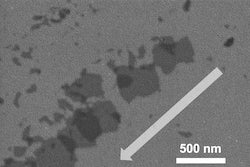
https://news-network.rice.edu/news/files/2022/07/0718_BORON-1-WEB.jpg
Particles of mechanically sheared flash boron nitride, as seen through a scanning electron microscope. The arrow shows the direction of shear force applied to the material. The flash Joule heating process developed at Rice University creates turbostratic materials with weak interactions between layers, making them easier to separate. (Credit: Tour Group/Rice University)
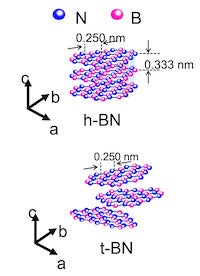
https://news-network.rice.edu/news/files/2022/07/0718_BORON-2-WEB.jpg
An illustration compares flakes of hexagonal boron nitride, top, and turbostratic boron nitride, bottom, the latter synthesized through the flash Joule heating process developed at Rice University. Two-dimensional materials are turbostratic when interactions between their layers are weak, making them easier to separate and solubilize. (Credit: Tour Group/Rice University)
- Related materials
-
Rice lab turns trash into valuable graphene in a flash: https://news.rice.edu/news/2020/rice-lab-turns-trash-valuable-graphene-flash
Cars could get a “flashy” upgrade: https://news.rice.edu/news/2022/cars-could-get-flashy-upgrade
Flashing plastic ash completes recycling: https://news.rice.edu/news/2021/flashing-plastic-ash-completes-recycling
Machine learning fine-tunes flash graphene: https://news.rice.edu/news/2022/machine-learning-fine-tunes-flash-graphene
Tour Group: https://www.jmtour.com
Department of Chemistry: https://chemistry.rice.edu
Wiess School of Natural Sciences: https://naturalsciences.rice.edu
- About Rice
-
Located on a 300-acre forested campus in Houston, Rice University is consistently ranked among the nation’s top 20 universities by U.S. News & World Report. Rice has highly respected schools of Architecture, Business, Continuing Studies, Engineering, Humanities, Music, Natural Sciences and Social Sciences and is home to the Baker Institute for Public Policy. With 4,240 undergraduates and 3,972 graduate students, Rice’s undergraduate student-to-faculty ratio is just under 6-to-1. Its residential college system builds close-knit communities and lifelong friendships, just one reason why Rice is ranked No. 1 for lots of race/class interaction and No. 1 for quality of life by the Princeton Review. Rice is also rated as a best value among private universities by Kiplinger’s Personal Finance.

